【c++】入门4
发布时间:2024年01月12日
内联函数声明和定义不能分开
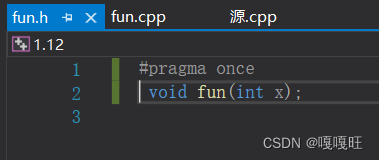
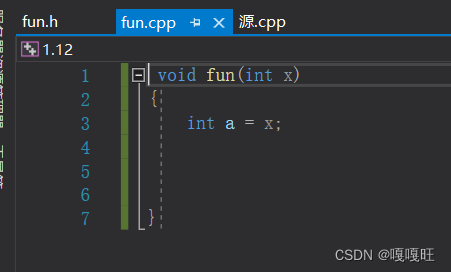
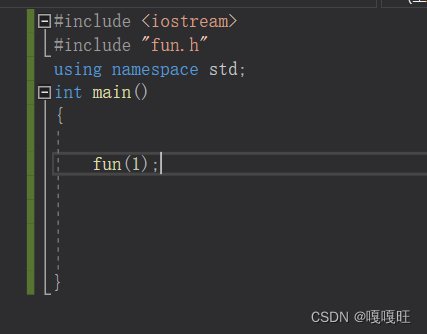
inline不建议声明和定义分离,分离会导致链接错误。因为inline被展开,就没有函数地址
了,链接就会找不到。
auto关键字
随着程序越来越复杂,程序中用到的类型也越来越复杂,经常体现在:
- 类型难于拼写
- 含义不明确导致容易出错
我们可以想到可以通过typedef给类型取别名,使用typedef给类型取别名确实可以简化代码,但是typedef有会遇到新的难题:
#include <iostream>
using namespace std;
typedef char* pstring;
int main()
{
const pstring p1; // 编译成功还是失败?
const pstring* p2; // 编译成功还是失败?
return 0;
}
在编程时,常常需要把表达式的值赋值给变量,这就要求在声明变量的时候清楚地知道表达式的
类型。然而有时候要做到这点并非那么容易,因此C++11给auto赋予了新的含义。
#include <iostream>
using namespace std;
typedef char* pstring;
int main()
{
const pstring p1=nullptr; // 编译成功还是失败?
const pstring* p2; // 编译成功还是失败?
return 0;
}
auto可以自动推断出变量的类型
#include <iostream>
using namespace std;
int main()
{
int a = 5;
auto b = a;
auto c = &a;
cout << typeid(b).name() << endl;
cout << typeid(c).name() << endl;
}
在c++中使用这个typeid(变量名).name()会知道变量类型
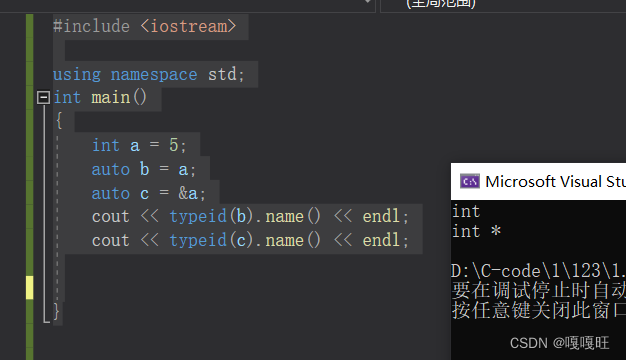
【注意】
使用auto定义变量时必须对其进行初始化,在编译阶段编译器需要根据初始化表达式来推导auto
的实际类型。因此auto并非是一种“类型”的声明,而是一个类型声明时的“占位符”,编译器在编
译期会将auto替换为变量实际的类型。
#include <iostream>
using namespace std;
int main()
{
int a = 5;
auto c = &a;
auto* d = &a;
cout << typeid(c).name() << endl;
cout << typeid(d).name() << endl;
}
auto后面加一个*是说明d变量是个指针类型.
在同一行定义多个变量
当在同一行声明多个变量时,这些变量必须是相同的类型,否则编译器将会报错,因为编译
器实际只对第一个类型进行推导,然后用推导出来的类型定义其他变量。
void main()
{
auto a = 1, b = 2;
auto c = 3, d = 4.0; // 该行代码会编译失败,因为c和d的初始化表达式类型不同
}
基于范围的for循环
#include <iostream>
using namespace std;
int main()
{
int arr[] = { 5,4,9,6,3,1,8,7,5 };
for (int i = 0; i < sizeof(arr) / sizeof(arr[0]); i++)
{
cout << arr[i] << endl;
}
}
如果使用语法糖的话
#include <iostream>
using namespace std;
int main()
{
int arr[] = { 5,4,9,6,3,1,8,7,5 };
for (auto a : arr)
{
cout << a << " ";
}
}
这样会方便很多.目前只适用于数组
指针空值nullptr
#include <iostream>
using namespace std;
void f(int)
{
cout << "f(int)" << endl;
}
void f(int*)
{
cout << "f(int*)" << endl;
}
int main()
{
f(0);
f(NULL);
return 0;
}
NULL实际是一个宏,在传统的C头文件(stddef.h)中,可以看到如下代码:
#ifndef NULL
#ifdef __cplusplus
#define NULL 0
#else
#define NULL ((void *)0)
#endif
#endif
可以看到,NULL可能被定义为字面常量0,或者被定义为无类型指针(void*)的常量。
对于上面两个重载函数,都会被认为调用的是第一个函数
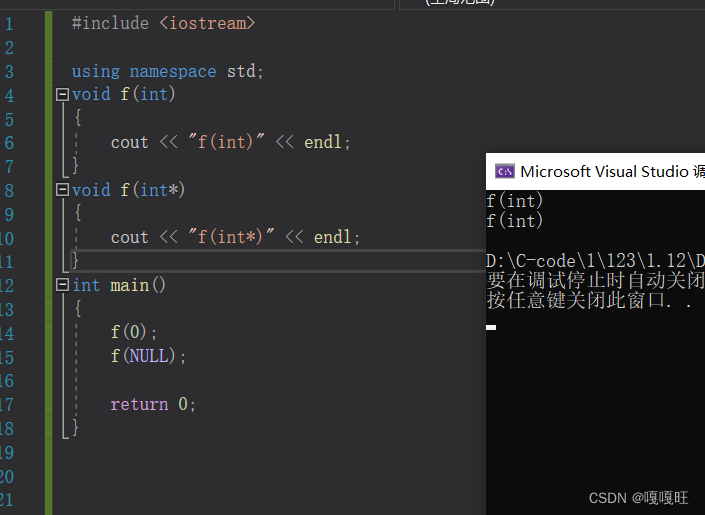
#include <iostream>
using namespace std;
void f(int)
{
cout << "f(int)" << endl;
}
void f(int*)
{
cout << "f(int*)" << endl;
}
int main()
{
f(0);
f(nullptr);
return 0;
}
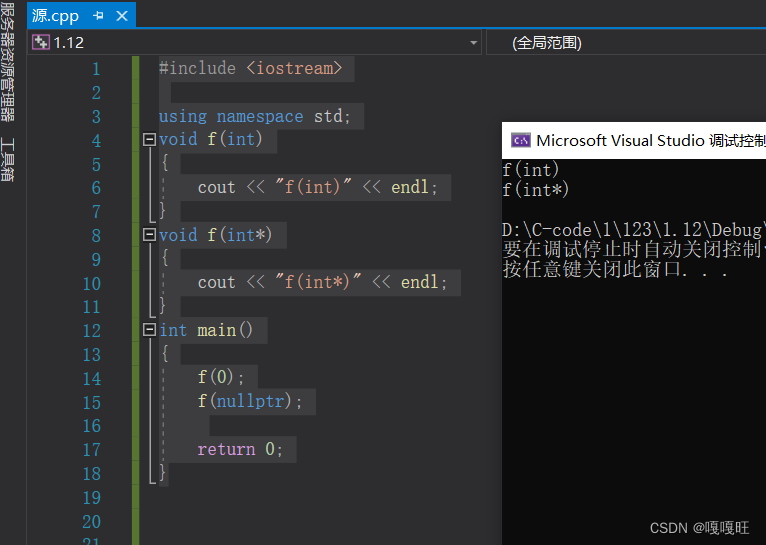
程序本意是想通过f(NULL)调用指针版本的f(int*)函数,但是由于NULL被定义成0,因此与程序的
初衷相悖。
注意:
- 在使用nullptr表示指针空值时,不需要包含头文件,因为nullptr是C++11作为新关键字引入
的。 - 在C++11中,sizeof(nullptr) 与 sizeof((void*)0)所占的字节数相同。
- 为了提高代码的健壮性,在后续表示指针空值时建议最好使用nullptr。
文章来源:https://blog.csdn.net/yyqzjw/article/details/135554277
本文来自互联网用户投稿,该文观点仅代表作者本人,不代表本站立场。本站仅提供信息存储空间服务,不拥有所有权,不承担相关法律责任。 如若内容造成侵权/违法违规/事实不符,请联系我的编程经验分享网邮箱:chenni525@qq.com进行投诉反馈,一经查实,立即删除!
本文来自互联网用户投稿,该文观点仅代表作者本人,不代表本站立场。本站仅提供信息存储空间服务,不拥有所有权,不承担相关法律责任。 如若内容造成侵权/违法违规/事实不符,请联系我的编程经验分享网邮箱:chenni525@qq.com进行投诉反馈,一经查实,立即删除!
最新文章
- Python教程
- 深入理解 MySQL 中的 HAVING 关键字和聚合函数
- Qt之QChar编码(1)
- MyBatis入门基础篇
- 用Python脚本实现FFmpeg批量转换
- python基础语法(一)变量
- 街道/楼体LED灯光亮化设计方案及驱动芯片SM16512P的应用与优势
- 桥接模式之多融资场景多交易的设计方案
- 喜报!巨蟹数科荣获国家“高新技术企业”认定!
- 【K8S 云原生】K8S的对外服务—ingress
- 实训案例|上海控安SmartRocket TestGrid(教育版)支持新工科实训课程方案
- Vue-组件缓存-keep-alive
- 取火柴游戏
- 虚拟机网络模式
- 仓储园区3D可视化:开启智能管理新时代